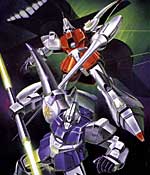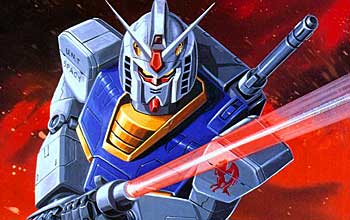by Paul Sudlow
Star Trek is a huge franchise, with five television series (including the upcoming Enterprise), nine movies, thousands of books, CDs and toys, and even a simulator ride in Las Vegas. Movie for movie, season for season, product for product, dollar for dollar, there is only one other franchise in the world which comes close to matching this record, and it's only just hit the American mainstream - Sunrise's "Gundam" saga. Since its launch in the late '70s, the "Gundam" franchise has racked up nine television series, eight movies, four original video series, and a surfeit of model kits, toys, CDs, and � yes � simulator rides in Japan. The Robot That Shook the Anime World The "Gundam" juggernaut got off to an unsteady start on the evening of April 7, 1979 when Studio Sunrise's "Mobile Suit Gundam" debuted on Japanese television. In those heady post-Star Wars days, big-event sci-fi films like "Star Trek," "Alien" and the "Space Cruiser Yamato" movies were packing theaters, so it seemed the perfect time to release a robot saga for a new generation. As it turns out, audiences were looking to get their sci-fi fix in theaters, not on the small screen -- "Gundam" fizzled on television and was canceled, but two years later roared into new life when creator Yoshiyuki Tomino repackaged the series as a movie trilogy. He hit solid gold with audiences, and the giant red, white and blue robot hasn't stopped since. "Mobile Suit Gundam" took genre staples like giant robots, teen heroes and high melodrama, and blended them with revolutionary new ideas which reinvented the mecha genre, ideas which today have been fully assimilated into the anime mainstream. In fact, so firmly has it anchored itself to the anime bedrock that one of Japan's major anime industry mags, NewType, is named after Gundam's race of evolved humans with combat-enhancing ESP powers.
"Gundam" introduced viewers to a complex world of mecha battles, political intrigue and romance; the setting: a future civil war between the Earth Federation and the Principality of Zeon (an orbiting superpower bent on independence). Central to the plot were two Newtypes, young Amuro Ray, reluctant ace pilot of the Earth Federal Forces, and charismatic Char Aznable, champion of Zeon. Rivals in psychic power, political affiliation and even love, most intriguingly, they also had the same goal -- the utter destruction of Zeon. The battles unfolding on the screen during the original season -- depicting the rise and fall of the Zeon government -- were collectively known as the One Year War. For the first time, the giant robot was a mass-produced weapon of war rather than the unique "pal" of the boy hero or senshi team. This single innovation laid down the foundation for mecha shows to come, from "Macross" and "Votoms" in the '80s to "Evangelion," "Patlabor" and "Escaflowne" in the '90s. And what a robot! "Gundam's" long line of fantastic designs guaranteed hot toy and model kit sales, and made a mint for Bandai, the toy company licensing "Gundam" rights from Sunrise. |

